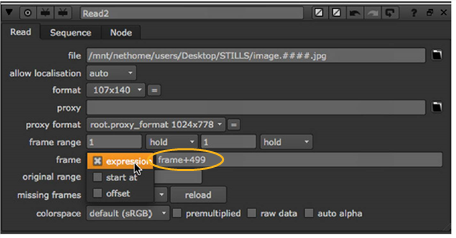
By default, Nuke assumes an exact relation between the current frame processed, and the frame read in. For example, at frame 15, Nuke reads in image.0015.rgb. However, you can change this behavior using the frame parameter on the Read node. For instance, if you have a sequence that runs from image.0500.rgb to image.1000.rgb, you may want to read in image.0500.rgb at frame 1. Nuke lets you do this via expressions, specified start frames, and constant offsets. Each method is described below.
| 1. | Select Image > Read to import an image sequence. |
| 2. | In the Read node controls, set the frame dropdown menu to expression. Enter an expression in the field on the right. The expression changes the relation between the current frame and the frame read in. |

For example, if your clip begins from image.0500.rgb and you want to place this first frame at frame 1 rather than frame 500, you can use the expression frame+499. This way, 499 frames are added to the current frame to get the number of the frame that’s read in. At frame 1, image.0500.rgb is read in; at frame 2, image.0501.rgb is read in; and so on.
Another example of an expression is frame*2. This expression multiplies the current frame by two to get the number of the frame that’s read in. This way, only every other frame in the clip is used. At frame 1, image.0002.rgb is read in; at frame 2, image.0004.rgb is read in; at frame 3, image.0006.rgb is read in; and so on.
| 1. | Select Image > Read to import an image sequence. |
| 2. | In the Read node controls, set the frame dropdown menu to start at. Enter a start frame number in the field on the right. This specifies the frame where the first frame in the sequence is read in. In other words, all frames are offset so that the clip starts at the specified frame. |
For example, if your sequence begins from image.0500.rgb and you enter 1 in the field, image0500.rgb is read in at frame 1. Similarly, if you enter 100 in the field, image0500.rgb is read in at frame 100.
| 1. | Select Image > Read to import an image sequence. |
| 2. | In the Read node controls, set the frame dropdown menu to offset. Enter a constant offset in the field on the right. This constant value is added to the current frame to get the number of the frame that’s read in. |
For example, if your clip begins from image.0500.rgb and you want to place this first frame at frame 1 rather than frame 500, you can use 499 as the constant offset. This way, 499 is added to the current frame to get the frame that’s read in. At frame 1, image.0500.rgb is read in; at frame 2, image.0501 is read in, and so on.
You can also use negative values as the constant offset. For example, if you use the value -10, Nuke subtracts ten from the current frame to get the frame that’s read in. At frame 20, image.0010.rgb is read in; at frame 21, image.0011.rgb is read in; and so on.